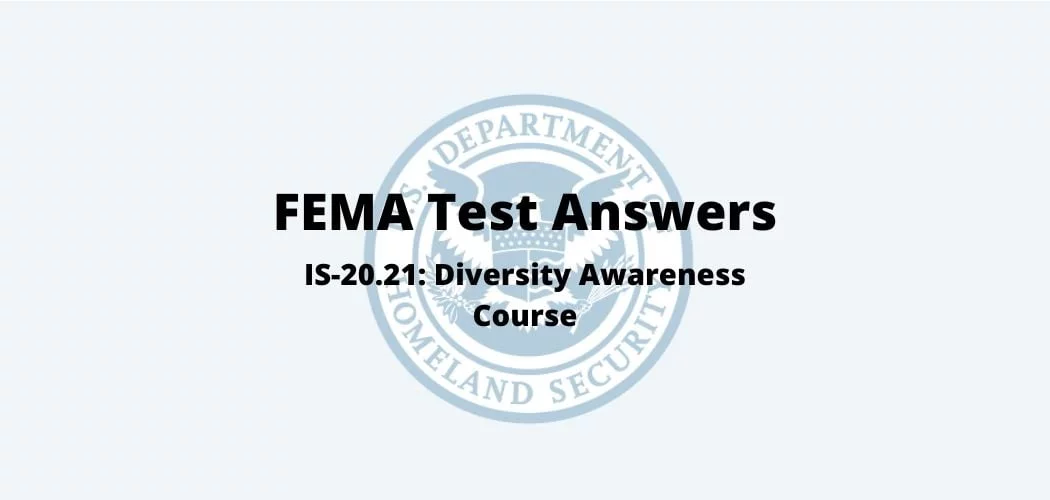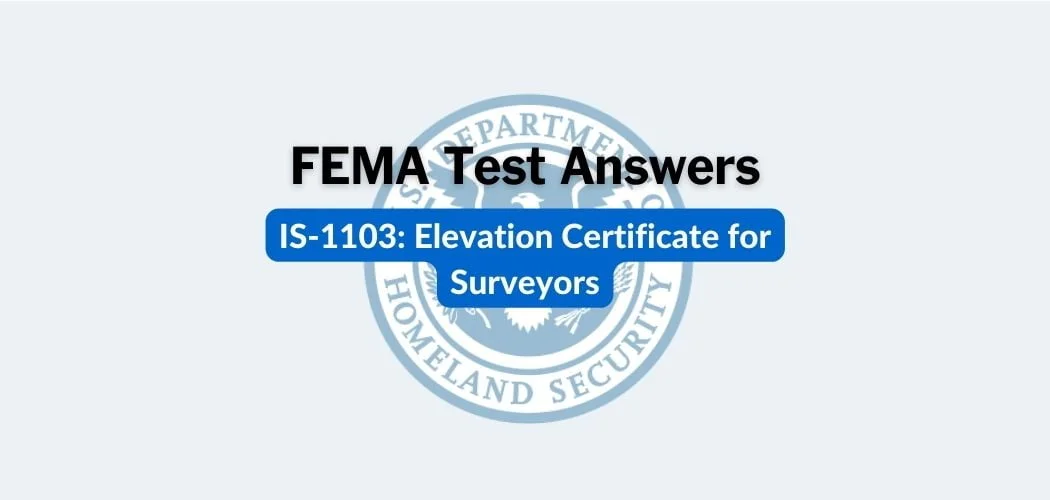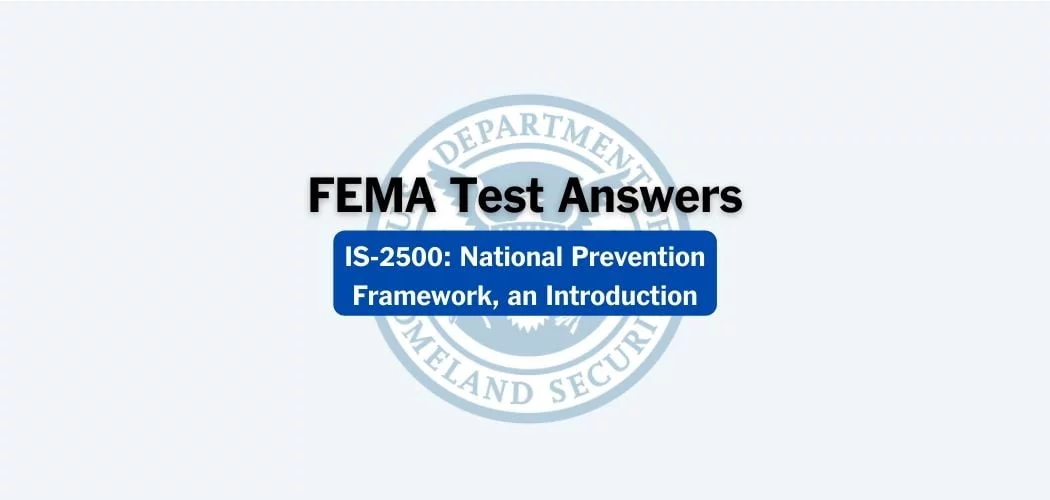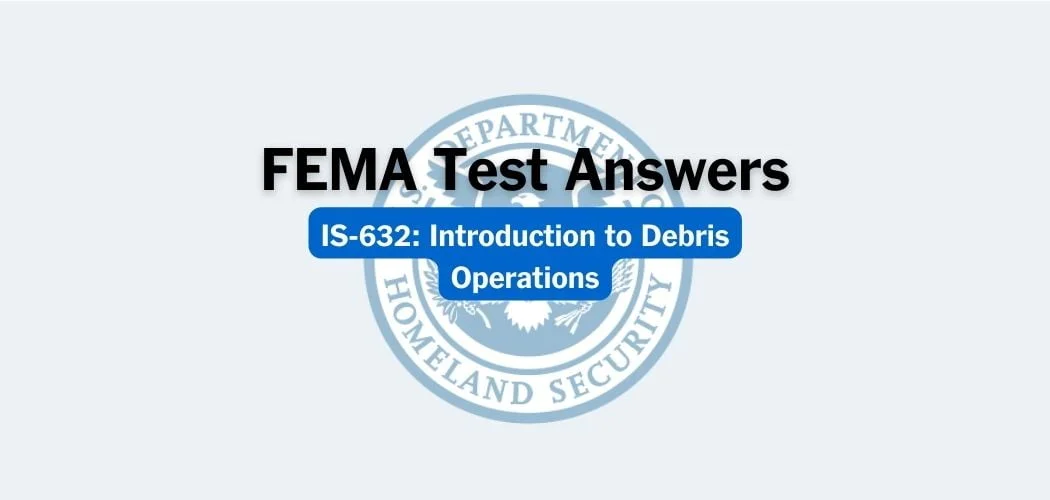Overview: FEMA IS-230.E was published on 6/15/2021 to provide all FEMA employees with basic information to prepare them for incident management and support activities.
Additionally, the IS-230.E course will provide an overview of FEMA, introduce basic emergency management concepts, and provide a high-level look at how FEMA meets its mission.
FEMA IS-230.E test answers
Each time this test is loaded, you will receive a unique set of questions and answers. The test questions are scrambled to protect the integrity of the exam.
Question 1. What capabilities focus on reducing loss of life and property by lessening the impact of disasters?
A. Protection
B. Response
C. Mitigation✅
D. Management
Question 2. Emergency managers create and sustain broad and sincere relationships among individuals and organizations to encourage trust; advocate a team atmosphere; build consensus; and facilitate communication. This statement describes which emergency management principle?
A. Integrated
B. Coordinated
C. Collaborative✅
D. Flexible
Question 3. Which of the following is an example of a prevention activity?
A. Passing an ordinance on controlling development in a floodplain
B. Requiring identification for site access✅
C. Setting up a network of clinics to provide neighborhood-based healthcare access for residents affected by a hurricane
D. Mobilizing search and rescue teams
Question 4. Emergency managers consider and take into account all threats/hazards; all phases; all stakeholders; and all impacts relevant to disasters. This statement describes which emergency management principle?
A. Comprehensive✅
B. Risk-Driven
C. Progressive
D. Integrated
Question 5. ____ has emergency services departments capable of responding to emergencies that include law enforcement; fire/emergency medical services; and public works.
A. FEMA✅
B. State government
C. Federal Government
D. Local governments
Question 6. Which FEMA mitigation program assists in implementing long-term hazard mitigation measures following Presidential disaster declarations?
A. Hazard Mitigation Grant Program (HMGP)✅
B. Repetitive Flood Claims (RFC)
C. Pre-Disaster Mitigation (PDM)
D. Severe Repetitive Loss (SRL)
Question 7. Due to their remote locations, _______ often face unique challenges in receiving assistance from outside the jurisdiction quickly and often request assistance from neighboring islands, other nearby countries, States, the private sector or nongovernmental organization resources, or the Federal Government.
A. state governments
B. tribal governments
C. territories and insular area governments✅
D. local governments
Question 8. States delegate authority to their sub-units of government (including counties; municipalities; towns or townships; and villages). This delegation creates local autonomy and limits the degree of State influence in local affairs. What is the term used to describe this delegation?
A. Jurisdictional autonomy
B. Home rule✅
C. Limits of power
D. Self-governance
Question 9. Identifying threats and hazards and applying physical; technological; and cyber measures to limit access are examples of capabilities that support which mission areas?
A. Mitigation and Management
B. Preparedness and Policing
C. Response and Recovery
D. Protection and Prevention✅
Question 10. What capabilities focus on saving lives; protecting property and the environment; and meeting basic human needs and begin when an incident is imminent or immediately after an event occurs?
A. Readiness
B. Recovery
C. Response✅
D. Rescue
Question 11. _____ is responsible for coordinating Federal resources that support State; local; tribal; and territorial efforts when a Federal emergency or disaster is declared.
A. FEMA✅
B. Local government
C. State government
D. Regional government
Question 12. Categorizing; by capability; the resources requested; deployed; and used in incidents is referred to as:
A. Resource cataloging
B. Resource typing✅
C. Resource classifying
D. Resource grouping
Question 13. Which of the following statements about the Stafford Act is correct? Under the Stafford Act:
A. The Federal assistance available for major disasters is more limited than that which is available for emergencies.
B. The types of incidents that may qualify as major disasters are extremely broad.
C. An emergency is defined as any natural catastrophe for which in the determination of the President Federal assistance is needed to supplement State; tribal; and local efforts and capabilities to save lives.
D. The President may only declare a major disaster at the request of a Governor or tribal Chief Executive who certifies the State or tribal government and affected local governments are overwhelmed.✅
Question 14. Which of the following is NOT a key function of the Multiagency Coordination System?
A. Situation assessment
B. Interagency activities
C. Critical resource planning✅
D. Incident command
Question 15. Local elected or appointed officials
A. May need to help shape or modify laws; policies; and budgets to aid preparedness efforts and to improve emergency management and response capabilities.✅
B. Conduct a preliminary damage assessment and submit documentation to FEMA requesting a Federal disaster declaration.
C. Should be present at the Incident Command Post to direct the first responders in executing tactical operations.
D. Delegate responsibility for emergency management and typically are not involved in the incident response and recovery.
Question 16. When an incident occurs that exceeds or is anticipated to exceed local or State resources—or when an incident is managed by Federal departments or agencies acting under their own authorities—the Federal Government uses the _______ to involve all necessary department and agency capabilities, organize the Federal response, and ensure coordination with response partners.
A. Incident Command System✅
B. State Training and Exercise System
C. Community Response System
D. National Response Framework
Question 17. Which of the following statements is FALSE?
A. Government agencies are responsible for protecting the lives and property of their citizens and promoting their well-being. However; the government does not and cannot work alone.
B. While private-sector organizations are important in building resilient communities before an incident occurs they play a limited role if any during an incident.✅
C. Private and nonprofit sectors are encouraged to develop contingency plans and to work with State; tribal; and local planners to ensure that their plans are consistent with other pertinent plans.
D. Nonprofit organizations bolster and support government efforts. These organizations collaborate with responders; governments at all levels; and other agencies and organizations.
Question 18. Which part of the emergency operations plan includes the Purpose; Scope; Situation Overview; Assumptions; Concept of Operations; and Organization and Assignment of Responsibilities?
A. Executive Summary
B. Annexes
C. Basic Plan✅
D. Appendixes
Question 19. The Whole Community concept means that residents; emergency management practitioners; organization and community leaders; and government officials:
A. Become self-reliant in responding to disaster so that they will not need to request assistance through mutual aid or other means.
B. Work together to assess the needs of their respective communities and determine the best ways to organize and strengthen their assets; capacities; and interests.✅
C. Rely on the expertise and resources of the Federal Government to rebuild their communities in a safer, stronger way following a disaster.
D. Prioritize which members of the community will receive assistance if the response and recovery resources are limited.
Question 20. Which mission area includes restoring health and social services networks and returning economic and business activities to a healthy state?
A. Recovery
B. Prevention
C. Response✅
D. Protection
Question 21. This authority emphasizes that Federal disaster assistance is intended to supplement; not supplant; the resources of State; local; and private-sector organizations.
A. Executive Order 10427✅
B. Post-Katrina Emergency Management Reform Act of 2006
C. Executive Order 12127
D. Sandy Recovery Improvement Act of 2013
Question 22. What type of measures considers ways to reduce consequences together with the overall risk from specific threats and other community goals?
A. Prevention
B. Mitigation✅
C. Response
D. Readiness
Question 23. The emergency operations plan is a key component of an emergency management program that:
A. Provides standard operating procedures for responding to specific types of incidents.
B. Serves primarily as a budgeting document for acquiring emergency management resources.
C. Establishes the overall authority; roles; and functions performed during incidents✅
D. Is required in order for a jurisdiction to receive Federal assistance with mitigation initiatives.
Question 24. Select the TRUE statement:
A. Long-term recovery can take months or years because it is a complex process of revitalizing homes; businesses; public infrastructure; the community’s economy; and restoring quality of life.✅
B. The primary focus of recovery is on the restoration of physical structures rather than returning economic and business activities to a healthy state.
C. Recovery efforts are most effective when jurisdictions wait until responders have completed all response activities.
D. Recovery is primarily a responsibility of local government. Therefore the Federal Government provides very limited assistance for recovery under the Stafford Act.
Question 25. Integrated emergency management is:
A. A detailed methodology used when needed to manage complex incidents that are beyond a jurisdiction’s capability.✅
B. Intended to create an organizational culture that is critical to achieving unity of effort between all stakeholders.
C. Used only during times of disasters and should not be integrated into the daily decision-making process within a jurisdiction.
D. A new concept to ensure that jurisdictions are prepared to respond to human-caused incidents, such as terrorist attacks.
Question 26. All of the following are important emergency management planning principles EXCEPT FOR:
A. Planning must be community-based representing the whole population and its needs.
B. Planning should be flexible enough to address both traditional and catastrophic incidents.
C. Planning is fundamentally a process to manage risk.
D. Planning results in unique plans for every type of threat or hazard.✅
Question 27. Which emergency management partner is responsible for coordinating all components of the emergency management system for a community?
A. Local emergency manager✅
B. FEMA
C. State Emergency Management Agency
D. State Governor
Question 28. Which of the following statements is FALSE?
A. Jurisdictions must work closely with private-sector entities that provide water; power; communications networks; transportation; medical care; security; and numerous other services.
B. Individuals and families can contribute by reducing hazards in and around their homes; developing a preparedness plan; and assembling emergency supplies.
C. Nongovernmental organizations often provide sheltering; emergency food supplies; counseling services; and other vital support services to support response and promote the recovery of disaster survivors.✅
D. Nonprofit organizations often have a commitment to the specific set of interests and values of their members; and therefore should be excluded from emergency management planning efforts.
Question 29. Which of the following statements about an emergency operations center (EOC) is correct?
A. To be most effective, an EOC should be organized according to Emergency Support Functions.
B. An EOC allows decision-makers to operate in one place to coordinate and communicate with support staff.✅
C. An EOC should be located as close to the incident site as possible.
D. Having multiple EOCs allows for more efficient management of resources.
Question 30. Which of the following answers best completes this statement: While every part of an emergency management program has its own role and function…
A. most emergency operations plans include functional annexes for the specific core functions implemented during an emergency.
B. local; State; tribal; and Federal governments; as well as private-sector agencies and individuals and families must share responsibility for applying mitigation resources effectively.
C. responsibility is shared among all.✅
D. local; State; tribal; and Federal governments; as well as private-sector agencies and individuals and families must share responsibility for effectively planning for actual disaster situations.
Question 31. Which of the following statements is incorrect? Specific areas of authority and responsibilities for emergency management should be clearly stated in local ordinances and laws. These ordinances and laws should:
A. Specify a specific line of succession for elected officials and require that departments of government establish lines of succession.✅
B. Define the process that allows all levels of government and all disciplines to work together more efficiently.
C. Explicitly state who has responsibility for emergency management daily operations; policy decisions affecting long-term emergency management; and final authority in actual disaster situations.
D. Define responsibilities; scopes of authority; and standards for the position of emergency program manager for an all-hazards integrated local emergency plan; and for mutual aid.
Question 32. Which of the following is NOT a feature of the Incident Command System?
A. Specialized code and terminology✅
B. Manageable span of control
C. Management by objectives
D. Pre-designated incident locations and facilities
Question 33. ________ is a core function implemented during an emergency.
A. Emergency public information✅
B. Finance and administration
C. Public education and information
D. Threat and hazard analysis
Question 34. In addition to emergency core functions; the emergency manager directs day-to-day program functions. An example of a day-to-day function is:
A. Direction; control; and coordination
B. Emergency public information✅
C. Public health and medical services
D. Hazard mitigation
Question 35. What level of government has direct responsibility for the safety of its residents and direct knowledge of the situation and accompanying resource requirements?
A. Federal Government
B. Local and tribal government✅
C. State government
D. Regional government
Question 36. Which emergency management partner is responsible for issuing state or area emergency declarations based on the damage estimates?
A. Local emergency manager
B. FEMA
C. State Emergency Management Agency
D. State Governor✅
Question 37. The local emergency manager has the responsibility for coordinating all components of the emergency management programs and activities for the community. A local emergency manager is responsible for all of the following activities EXCEPT FOR:
A. Managing resources before; during; and after a major emergency or disaster.
B. Identifying and analyzing the potential impacts of hazards that threaten the jurisdiction.
C. Coordinating with all partners in the emergency management process.
D. Developing an Incident Action Plan that specifies tactics for first responders✅
Question 38. Under the Stafford Act
A. The President may designate an incident as either an emergency or a major disaster.
B. The Secretary of Homeland Security is responsible for coordinating Government response efforts.
C. The Federal Government may provide unlimited Federal assistance to jurisdictions.
D. The FEMA Administrator may assume the authorities of local; tribal; and State authorities on a temporary basis.✅
Question 39. Emergency management principles
A. Create and sustain broad and sincere relationships among individuals and organizations
B. Defines emergency management as an extension of civil defense
C. Help us identify and apply agreed-upon practices✅
D. Give the President the authority to issue disaster declarations
Question 40. One key function of Emergency Operations Center (EOC) personnel is to
A. Determine tactical objectives and direction for managing the incident.
B. Assume chain of command for all personnel working at the incident scene.
C. Ensure that the Incident Commander has needed resources (i.e.personnel; tools; and equipment)✅
D. Establish the optimal span of control for supervising responders
Other popular FEMA test answers
- IS-005: An Introduction to Hazardous Materials
- IS-010: Animals in Disasters: Awareness and Preparedness
- IS-100: An Introduction to the Incident Command System (ICS)
- IS-120: An Introduction to Exercises
- IS-235: Emergency Planning
- IS-244: Developing and Managing Volunteers
- IS-363: Introduction to Emergency Management for Higher Education
- IS-700: An Introduction to the National Incident Management System
- IS-906: Workplace Security Awareness
- IS-907: Active Shooter: What You Can Do
- IS-909: Community Preparedness: Implementing Simple Activities for Everyone



